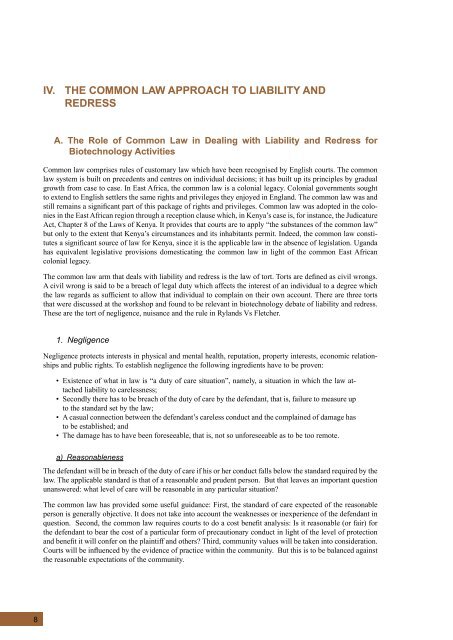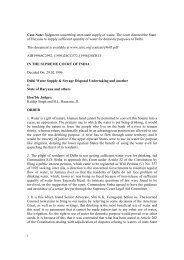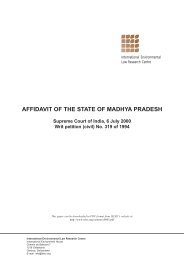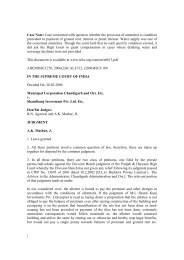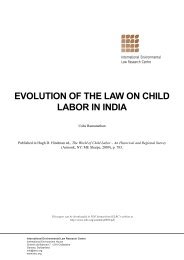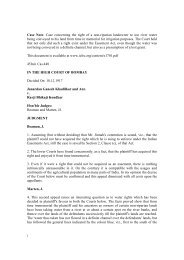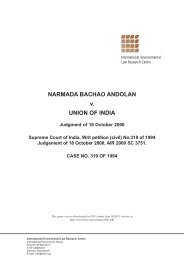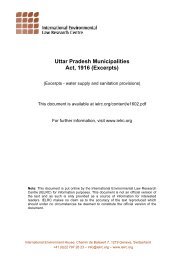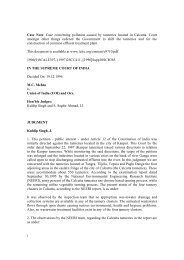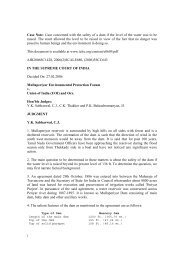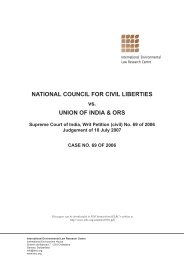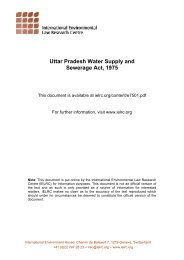IV. THE COMMON LAW APPROACH TO LIABILITY ANDREDRESSA. The Role of Common Law in Dealing with <strong>Liability</strong> <strong>and</strong> <strong>Redress</strong> forBiotechnology ActivitiesCommon law comprises rules of customary law which have been recognised by English courts. The commonlaw system is built on precedents <strong>and</strong> centres on individual decisions; it has built up its principles by gradualgrowth from case to case. In East Africa, <strong>the</strong> common law is a colonial legacy. Colonial governments soughtto extend to English settlers <strong>the</strong> same rights <strong>and</strong> privileges <strong>the</strong>y enjoyed in Engl<strong>and</strong>. The common law was <strong>and</strong>still remains a significant part of this package of rights <strong>and</strong> privileges. Common law was adopted in <strong>the</strong> coloniesin <strong>the</strong> East African region through a reception clause which, in Kenya’s case is, for instance, <strong>the</strong> JudicatureAct, Chapter 8 of <strong>the</strong> Laws of Kenya. It provides that courts are to apply “<strong>the</strong> substances of <strong>the</strong> common law”but only to <strong>the</strong> extent that Kenya’s circumstances <strong>and</strong> its inhabitants permit. Indeed, <strong>the</strong> common law constitutesa significant source of law for Kenya, since it is <strong>the</strong> applicable law in <strong>the</strong> absence of legislation. Ug<strong>and</strong>ahas equivalent legislative provisions domesticating <strong>the</strong> common law in light of <strong>the</strong> common East Africancolonial legacy.The common law arm that deals with liability <strong>and</strong> redress is <strong>the</strong> law of tort. Torts are defined as civil wrongs.A civil wrong is said to be a breach of legal duty which affects <strong>the</strong> interest of an individual to a degree which<strong>the</strong> law regards as sufficient to allow that individual to complain on <strong>the</strong>ir own account. There are three tortsthat were discussed at <strong>the</strong> workshop <strong>and</strong> found to be relevant in biotechnology debate of liability <strong>and</strong> redress.These are <strong>the</strong> tort of negligence, nuisance <strong>and</strong> <strong>the</strong> rule in Ryl<strong>and</strong>s Vs Fletcher.1. NegligenceNegligence protects interests in physical <strong>and</strong> mental health, reputation, property interests, economic relationships<strong>and</strong> public rights. To establish negligence <strong>the</strong> following ingredients have to be proven:• Existence of what in law is “a duty of care situation”, namely, a situation in which <strong>the</strong> law attachedliability to carelessness;• Secondly <strong>the</strong>re has to be breach of <strong>the</strong> duty of care by <strong>the</strong> defendant, that is, failure to measure upto <strong>the</strong> st<strong>and</strong>ard set by <strong>the</strong> law;• A casual connection between <strong>the</strong> defendant’s careless conduct <strong>and</strong> <strong>the</strong> complained of damage hasto be established; <strong>and</strong>• The damage has to have been foreseeable, that is, not so unforeseeable as to be too remote.a) ReasonablenessThe defendant will be in breach of <strong>the</strong> duty of care if his or her conduct falls below <strong>the</strong> st<strong>and</strong>ard required by <strong>the</strong>law. The applicable st<strong>and</strong>ard is that of a reasonable <strong>and</strong> prudent person. But that leaves an important questionunanswered: what level of care will be reasonable in any particular situation?The common law has provided some useful guidance: First, <strong>the</strong> st<strong>and</strong>ard of care expected of <strong>the</strong> reasonableperson is generally objective. It does not take into account <strong>the</strong> weaknesses or inexperience of <strong>the</strong> defendant inquestion. Second, <strong>the</strong> common law requires courts to do a cost benefit analysis: Is it reasonable (or fair) for<strong>the</strong> defendant to bear <strong>the</strong> cost of a particular form of precautionary conduct in light of <strong>the</strong> level of protection<strong>and</strong> benefit it will confer on <strong>the</strong> plaintiff <strong>and</strong> o<strong>the</strong>rs? Third, community values will be taken into consideration.Courts will be influenced by <strong>the</strong> evidence of practice within <strong>the</strong> community. But this is to be balanced against<strong>the</strong> reasonable expectations of <strong>the</strong> community.8
) ForeseeabilityThe foreseeability test is not one of <strong>the</strong> actual foresights of <strong>the</strong> defendant. Instead, it is what <strong>the</strong> court determinesto be foreseeable, after reviewing <strong>the</strong> evidence <strong>and</strong> trying to do justice. Why is this a good test? It is flexible<strong>and</strong> leaves a large element of discretion to courts. This is good because it enables courts to raise st<strong>and</strong>ardsof expected behaviour by insisting on better precautions being taken in advance. Thus it enables justice to bedone according to <strong>the</strong> merits of each individual case.c) Negligence <strong>and</strong> <strong>the</strong> <strong>Protocol</strong>The transboundary movement of LMOs could have a number of effects on ecosystems such as <strong>the</strong> crossing ofintroduced traits; herbicide resistance into wild relatives of <strong>the</strong> LMO; toxic effects produced on o<strong>the</strong>r organismsin <strong>the</strong> environment or on humans or livestock affected via <strong>the</strong> food chain. A number of questions arise:• Who should be liable in <strong>the</strong>se situations? Manufacturers, exporters, operators, exporting states,states of origin?• Who owes a duty of care?• What constitutes damage? Any degree of change of biodiversity?• Thresholds? Is <strong>the</strong> damage foreseeable?• Will “state of <strong>the</strong> art” defence be appropriate?• Should liability be strict? So that it does not matter that <strong>the</strong> defendant was not negligent.These questions cannot effectively be addressed in <strong>the</strong> abstract. They are best dealt with in <strong>the</strong> context of specificcases. This makes <strong>the</strong> tort of negligence a suitable regime for addressing <strong>the</strong>m. The tort of negligence can<strong>the</strong>refore effectively deal with <strong>the</strong> liability of manufacturers, exporters <strong>and</strong> operators. In <strong>the</strong>se cases, it wouldbe relatively easy for courts to determine whe<strong>the</strong>r <strong>the</strong>re are duties of care situations. Indeed, torts of such acharacter would be actionable if committed in Kenya, for instance, notwithst<strong>and</strong>ing <strong>the</strong>ir lack of basis forfounding an action in o<strong>the</strong>r jurisdictions. The idea of imposing liability on states for <strong>the</strong> acts of private entitiesis bound to be problematic. The State Action Doctrine is a doctrine of customary international law that seeks toestablish, in accordance with international law, actions or omissions attributable to <strong>the</strong> state as an internationalactor. The basic principle is that for acts or omissions to be attributed to <strong>the</strong> state at international level, <strong>the</strong>yhave to have been <strong>under</strong>taken by members or an organisation or agency of <strong>the</strong> state. Attribution, even in instancesinvolving recognised state organs, is problematic where <strong>the</strong>y have exceeded <strong>the</strong>ir competence or actedin outright contravention of municipal law.The tests of reasonableness <strong>and</strong> foreseeability make <strong>the</strong> tort of negligence a potentially effective tool for liability<strong>and</strong> redress for h<strong>and</strong>ling, transfer <strong>and</strong> use of LMOs. In particular, two features of LMOs make <strong>the</strong> tortunknown of negligence an appropriate liability <strong>and</strong> redress regime: first, <strong>the</strong> effects of LMOs are still largelyunknown so that any liability regime would be speculative at best. By contrast, a statutory liability regime isunlikely to anticipate all <strong>the</strong> possible harmful effects that might be generated by <strong>the</strong> manufacture <strong>and</strong> utilisationof LMOs. Second, LMOs may be dangerous <strong>and</strong> <strong>the</strong>refore a need for precaution arises.In applying <strong>the</strong>se tests, <strong>the</strong> courts should be guided by <strong>the</strong> provisions of relevant international instruments,including <strong>the</strong> <strong>Cartagena</strong> <strong>Protocol</strong>, which constitutes an expression of “reasonable expectations” of <strong>the</strong> internationalcommunity. For instance, <strong>the</strong> statement of <strong>the</strong> precautionary principle follows from an internationalrecognition of <strong>the</strong> need for <strong>and</strong> legitimacy of applying precaution in a situation of scientific uncertainty about<strong>the</strong> potential risks associated with particular uses of biotechnology. Whe<strong>the</strong>r or not <strong>the</strong>re is a duty of care situationwill depend on <strong>the</strong> level of compliance with <strong>the</strong> <strong>Protocol</strong>, e.g., whe<strong>the</strong>r <strong>the</strong>re was exporter notification orrisk assessment.Corruption would no doubt compound <strong>the</strong> case, but <strong>the</strong> level of liability will depend on <strong>the</strong> extent to whichone complied with requirements of <strong>the</strong> <strong>Protocol</strong>. Local courts need <strong>the</strong>refore not wait for <strong>the</strong>ir governments todomesticate international treaties. Where appropriate, <strong>the</strong>y should treat treaties as expressions of <strong>the</strong> reasonableexpectations of <strong>the</strong> people within <strong>the</strong>ir jurisdiction. Indeed some national constitutions such as <strong>the</strong> SouthAfrican one m<strong>and</strong>ate national courts to seek guidance from relevant international treaties.9


